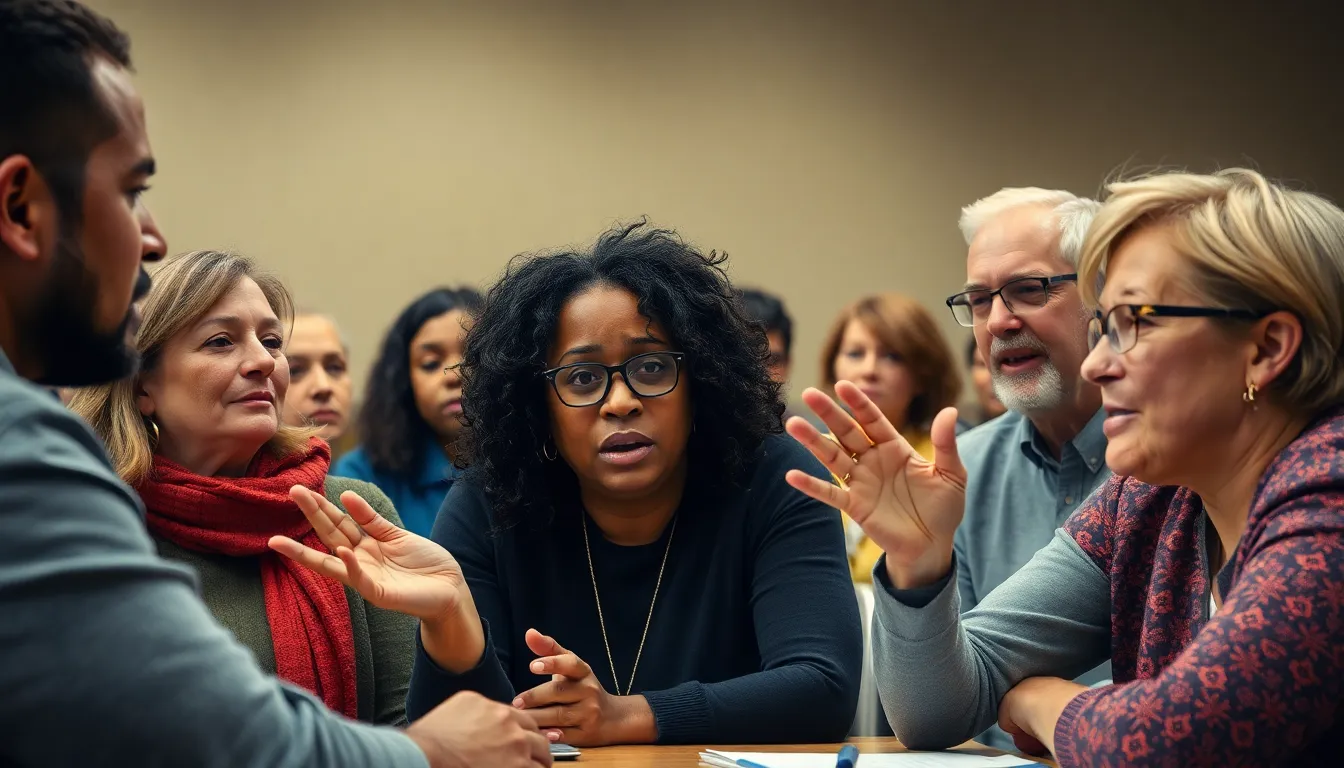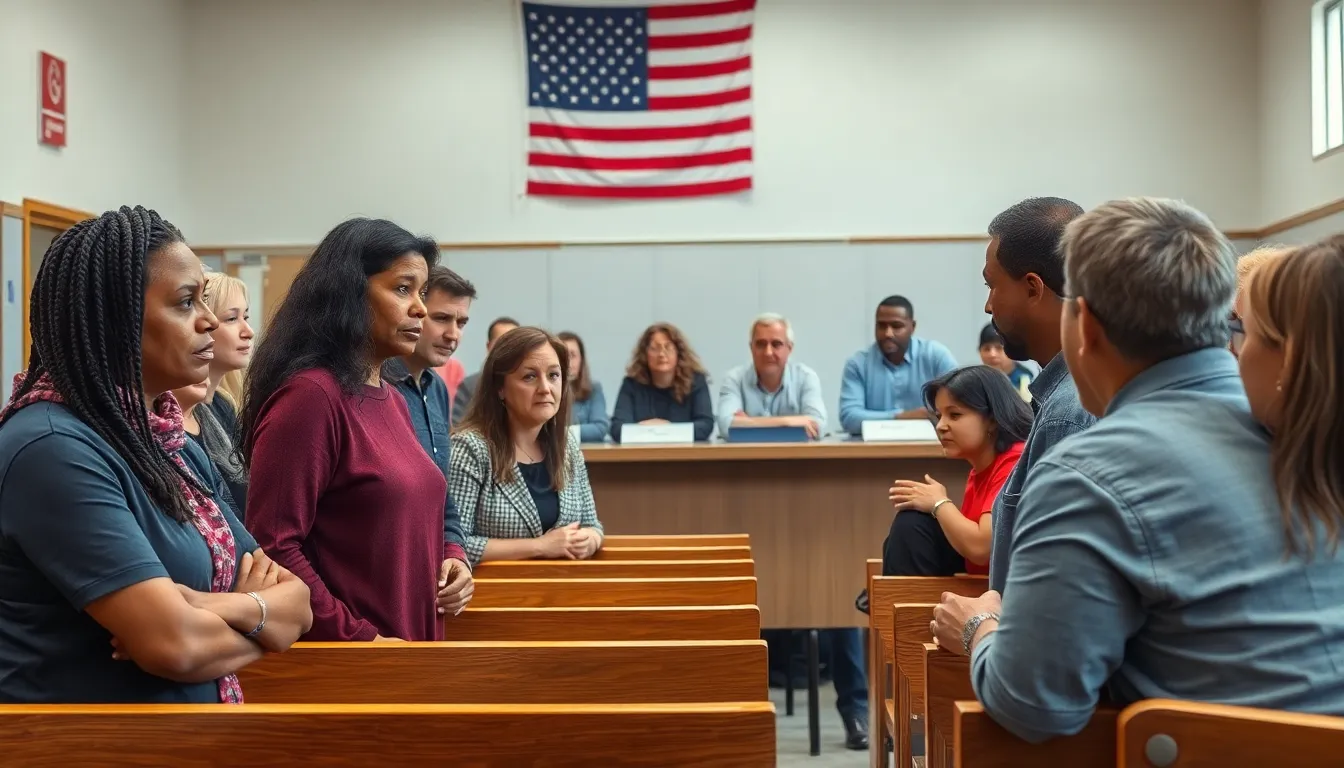In recent years, school boards have become battlegrounds for heated debates and polarizing opinions. As communities grapple with issues like curriculum changes, policy decisions, and the role of diversity in education, tensions have escalated. Parents, educators, and activists find themselves at odds, each advocating for their vision of what schools should represent.
These contentious discussions highlight the deep-seated values and beliefs that shape education today. With social media amplifying voices on both sides, the stakes have never been higher. Understanding the dynamics at play in school board meetings is crucial for anyone invested in the future of education. As the landscape continues to evolve, the outcomes of these debates will significantly impact students and communities alike.
Table of Contents
ToggleOverview of Contentious School Boards
Contentious school boards face heightened scrutiny as they navigate debates on curriculum changes, policy decisions, and inclusion initiatives. Parents, educators, and activists often clash over educational priorities, highlighting fundamental disagreements about the direction of schooling.
Conflict arises from differing values and beliefs. Parents advocate for specific curricular content, while teachers may prioritize pedagogical methods. Activists often call for greater diversity and representation within educational materials, expecting schools to reflect societal changes. These dynamics create a charged atmosphere during school board meetings.
Social media’s role in these debates cannot be overlooked. Platforms amplify voices, allowing rapid dissemination of opinions and information. This fosters public engagement but can also lead to misinformation and heightened tensions among stakeholders. Understanding the implications of social media on school board discussions is crucial for grasping the broader educational landscape.
The outcomes from school board decisions significantly impact students and communities. Policies enacted affect not only the immediate educational environment but can also influence community relations and future educational reforms. As debates continue, the need for constructive dialogue remains essential to address the diverse needs and expectations of all stakeholders.
Factors Contributing to Conflict

Multiple factors contribute to conflicts in school boards, often intertwining personal beliefs with educational policies. Understanding these factors provides insight into the contentious debates that schools face.
Political Influences
Political influences play a significant role in school board conflicts. Political groups often advocate for specific educational policies, aligning with broader ideological agendas. These groups may mobilize parents and community members to voice their opinions during school board meetings. Different political affiliations can lead to sharp divisions among stakeholders. For instance, policies on curricula related to history, science, and social studies frequently invoke political responses, as varying political ideologies shape beliefs about what students should learn. Consequently, the clash of these ideologies fosters an environment ripe for conflict.
Community Involvement
Community involvement significantly impacts school board dynamics. Active participation from parents, educators, and local organizations often reflects the community’s values and priorities. When community members feel their voices are not adequately represented, tensions can escalate. Conflicts often arise over contentious issues, such as curriculum content and budget decisions. Grassroots campaigns may emerge in response to perceived neglect or disagreement, bringing additional pressure on school boards to address community concerns. High levels of engagement, coupled with diverse opinions, can create a complex landscape in which conflicts are more likely to occur.
Case Studies of Contentious School Boards
Contentious school boards serve as microcosms of broader societal tensions, showcasing a range of disputes driven by differing educational philosophies and community values. Noteworthy examples and their outcomes illustrate the significant impacts these conflicts can have on educational systems.
Noteworthy Examples
- Chandler Unified School District, Arizona
Chandler faced intense debates over mask mandates during the COVID-19 pandemic. Parents were divided, some advocating for mandates while others pushed against them, resulting in heated school board meetings and significant community involvement.
- Tennessee School Board, Williamson County
Williamson County encountered disputes over a proposed diversity curriculum. Parents challenged the inclusion of specific materials, leading to extensive public forums and implications for overall board policies regarding inclusivity.
- Virginia’s Loudoun County Public Schools
Loudoun County experienced a surge of conflict over transgender rights policies. Parents and advocacy groups presented opposing views, creating a significant national conversation regarding student rights and school policy, with ramifications seen across the nation.
- California’s Capistrano Unified School District
Capistrano Unified dealt with controversies surrounding critical race theory (CRT) in curricula. Board meetings turned contentious as community members weighed in on CRT, affecting district policies and eliciting widespread media coverage.
Outcomes of Disputes
| Example | Outcome |
|---|---|
| Chandler Unified School District | Tensions led to temporary policy reversals regarding mask mandates, with ongoing debates influencing future health guidelines. |
| Williamson County, Tennessee | Adjustments to the proposed curriculum were made after public outcry, reflecting a blend of community feedback and board decision-making. |
| Loudoun County Public Schools | The board’s decision fostered polarized community responses, prompting further statewide discussions on educational policy and student rights. |
| Capistrano Unified School District | After protracted disputes, the board ultimately delayed implementation of CRT-related content, making way for revised community engagement strategies. |
Contentious school board disputes reflect the complexity of educational governance, highlighting how deeply personal beliefs shape policy decisions and school environments.
Impact on Students and Education
Contentious school board debates lead to significant impacts on students and the educational landscape. The ramifications of these conflicts can affect academic performance and shape the social climate within schools.
Academic Performance
Academic performance often suffers amid disputes. Students experience distractions from educational objectives, as heated discussions over curriculum content divert attention from learning. Research indicates that consistent disruptions in the educational environment can lower test scores and grades. For example, schools embroiled in policy disputes may struggle with curriculum alignment, leading to gaps in knowledge and reduced preparedness for higher education and career opportunities. Additionally, when students feel stress from ongoing conflicts, their focus and motivation can decline. Inconsistent policies and curricula can also create inequality, where some students receive a quality education while others face an unstable learning environment.
Social Climate
The social climate within schools frequently reflects the tensions present in school board debates. Conflicts over policies can foster an atmosphere of division, impacting student relationships and overall school culture. Instances of bullying or exclusion may increase as students take sides on contentious issues, leading to a less inclusive environment. Moreover, students who identify with marginalized communities often express feelings of vulnerability when policies regarding diversity, equity, and inclusion remain unresolved. Research suggests that a positive social climate correlates with high student engagement and well-being; thus, maintaining dialogue that addresses the diverse perspectives of stakeholders is crucial to fostering a supportive educational environment.
Strategies for Resolution
Resolving tensions within contentious school boards requires strategic approaches to foster dialogue and collaboration among stakeholders. Two effective resolutions include mediation approaches and community engagement initiatives.
Mediation Approaches
Mediation fosters constructive dialogue between conflicting parties within school boards. Trained mediators can facilitate discussions, allowing each stakeholder to express their concerns and interests. Mediators focus on finding common ground while addressing specific issues, such as curriculum content or policy changes. Schools may use interest-based negotiation techniques to prioritize collaborative solutions that satisfy diverse stakeholders. Implementing regular mediation sessions promotes transparency and builds trust among parents, educators, and administrators, essential for maintaining a positive educational environment.
Community Engagement
Active community engagement enhances stakeholder participation in school board discussions. Schools can develop initiatives that encourage dialogue, such as public forums, town hall meetings, and workshops. These events create platforms for parents and community members to voice their opinions and collaborate on educational policies. Schools should also utilize digital tools, like social media groups and online surveys, to reach a broader audience. By incorporating diverse perspectives and fostering a culture of inclusivity, school boards can effectively address concerns while strengthening community ties and support for educational programs.
Contentious school boards reflect broader societal tensions and differing educational philosophies. The ongoing debates highlight the need for constructive dialogue among parents, educators, and community members. By prioritizing collaboration and transparency, stakeholders can work towards solutions that benefit students and foster a supportive educational environment.
As these discussions evolve, the importance of inclusivity and representation cannot be overstated. Engaging diverse voices will help bridge divides and address the complex challenges facing education today. The path forward requires commitment from all parties to ensure that every student can thrive in a dynamic and equitable learning environment.



